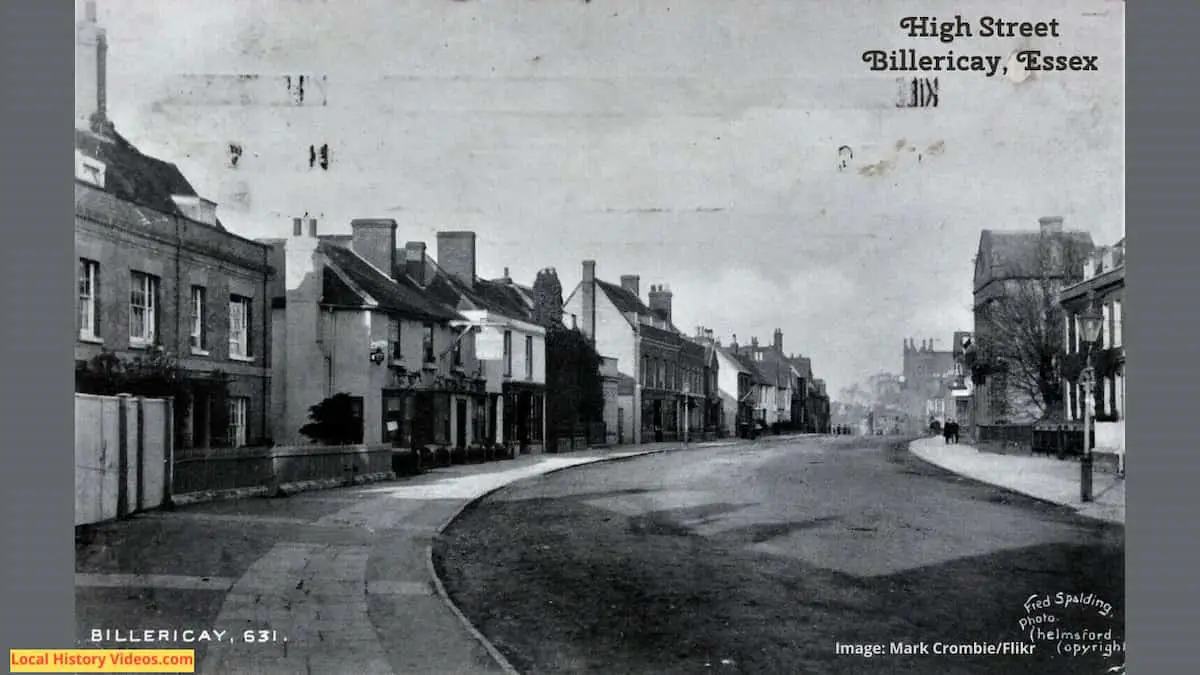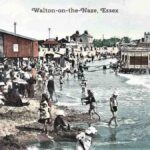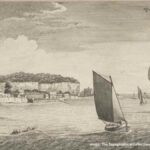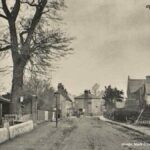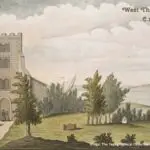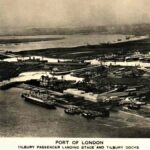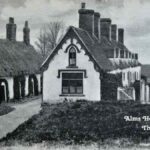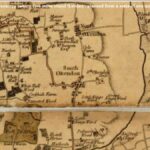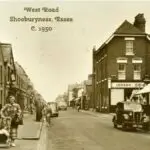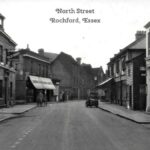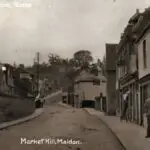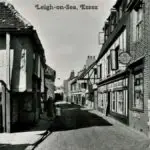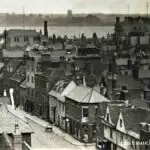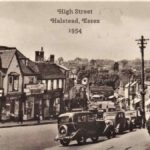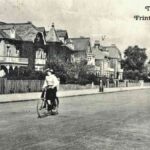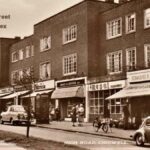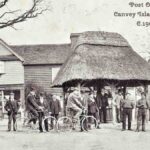Glimpse history through old images of Billericay, Essex.
Old Photos of Billericay
High Street
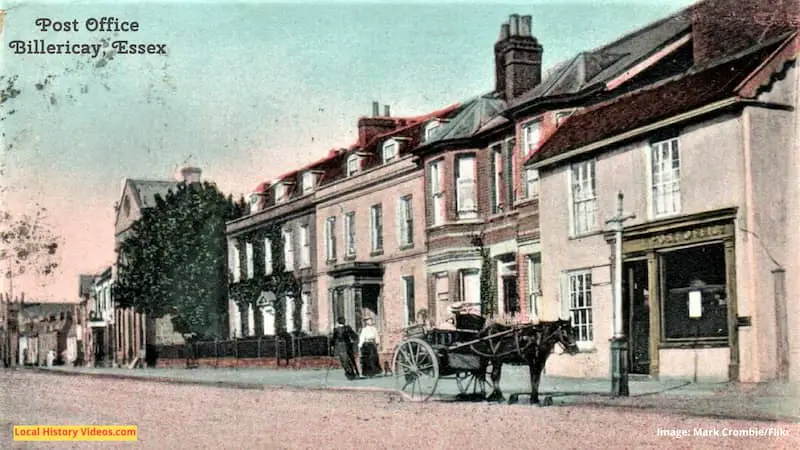
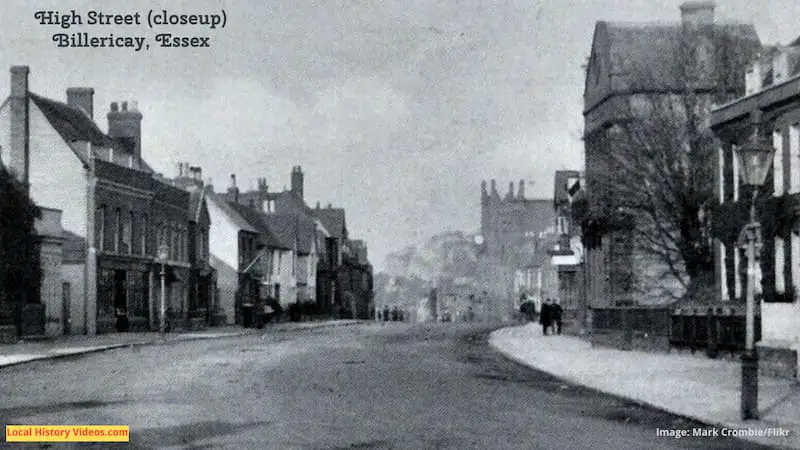
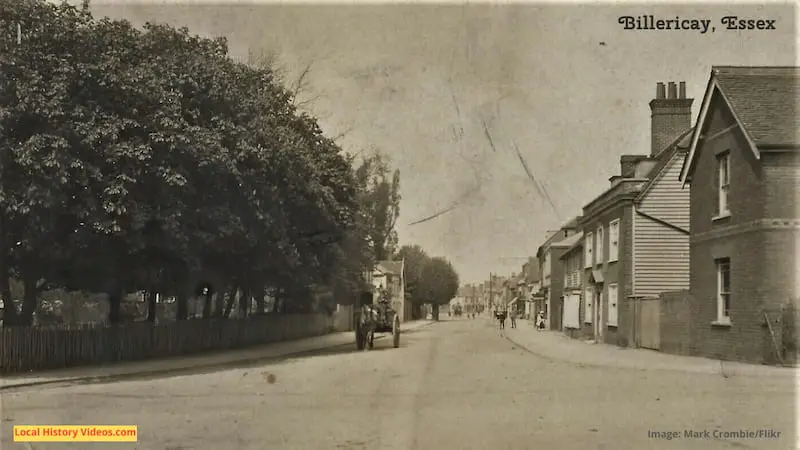
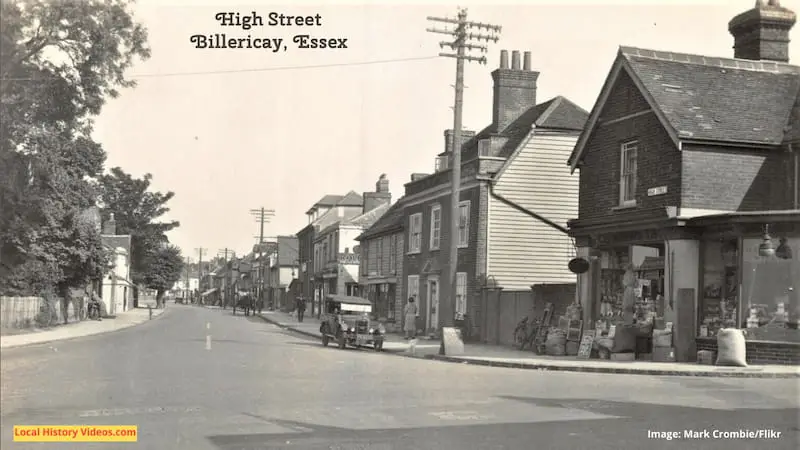
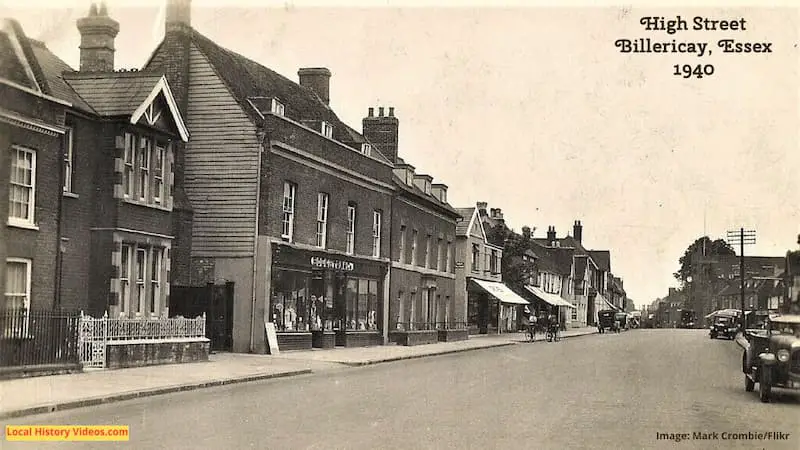
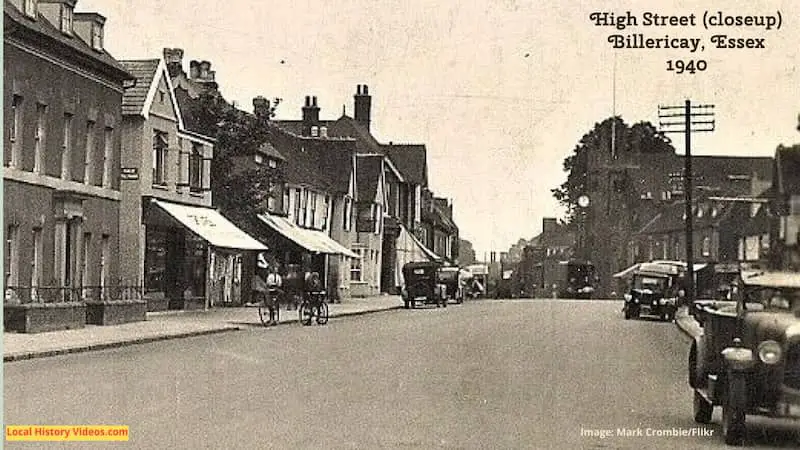
Chapel Street
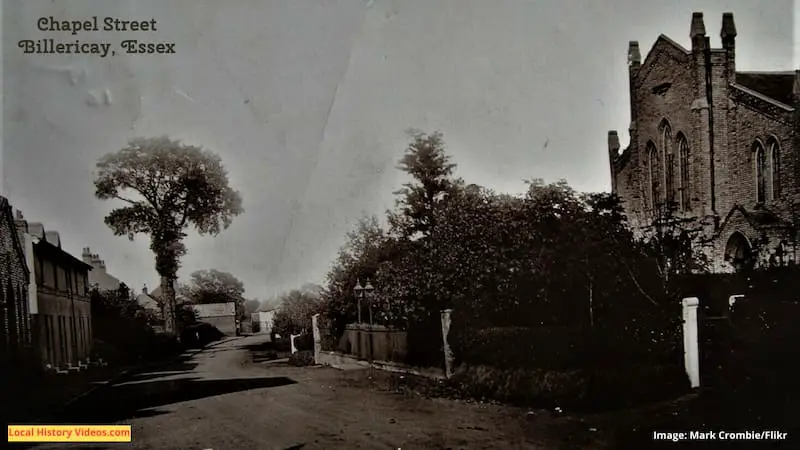
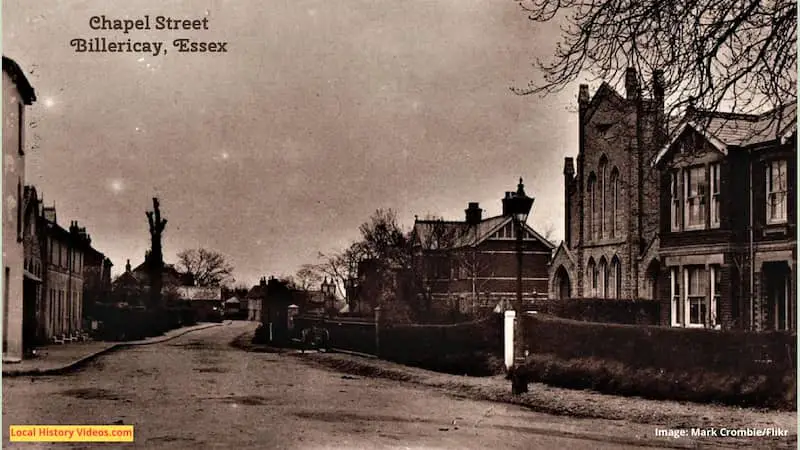
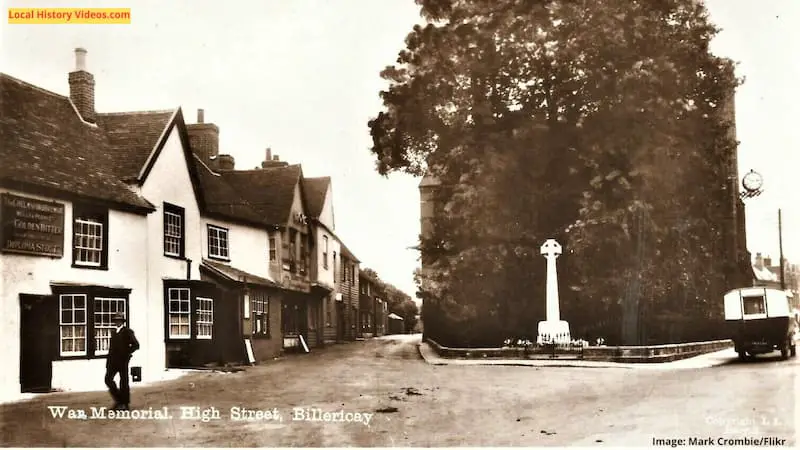
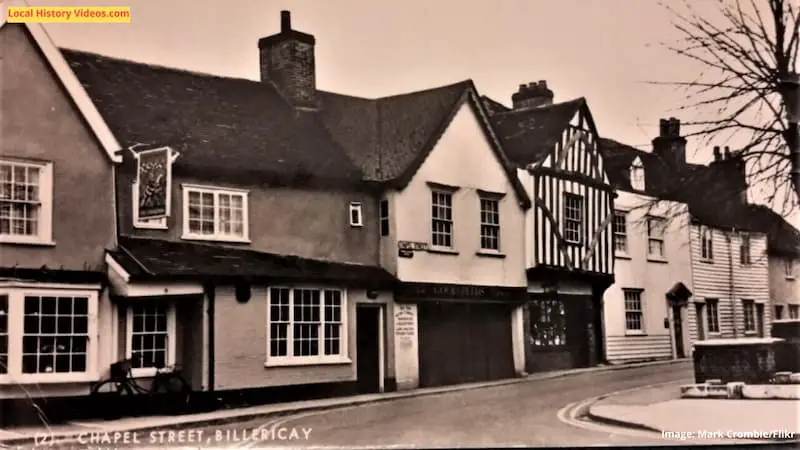
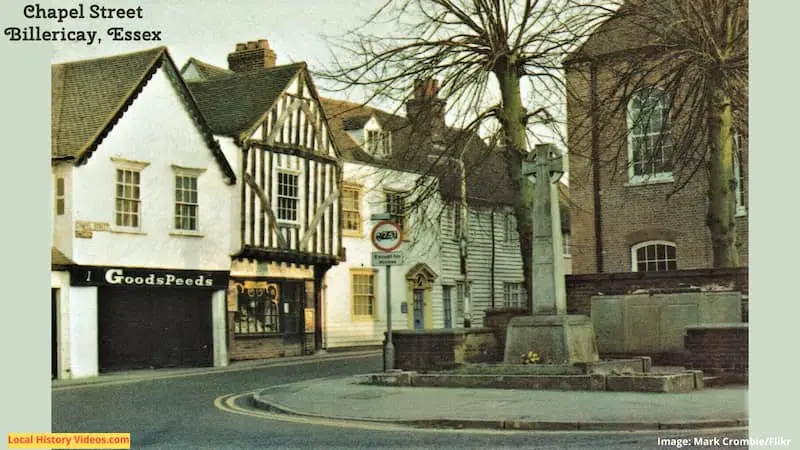
Other Streets
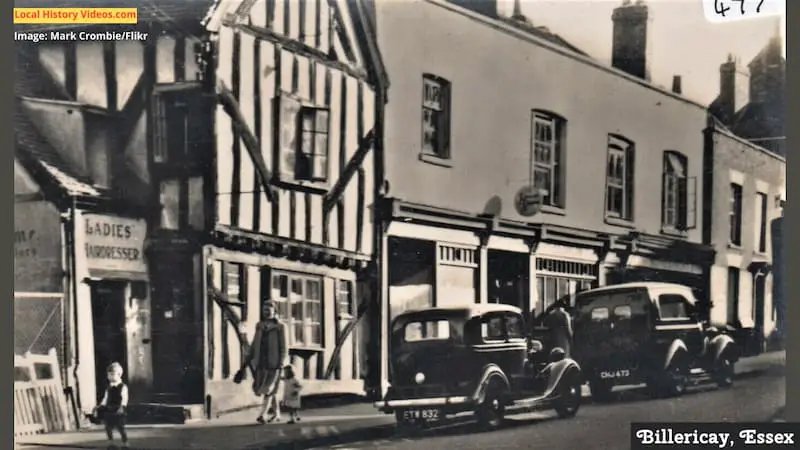
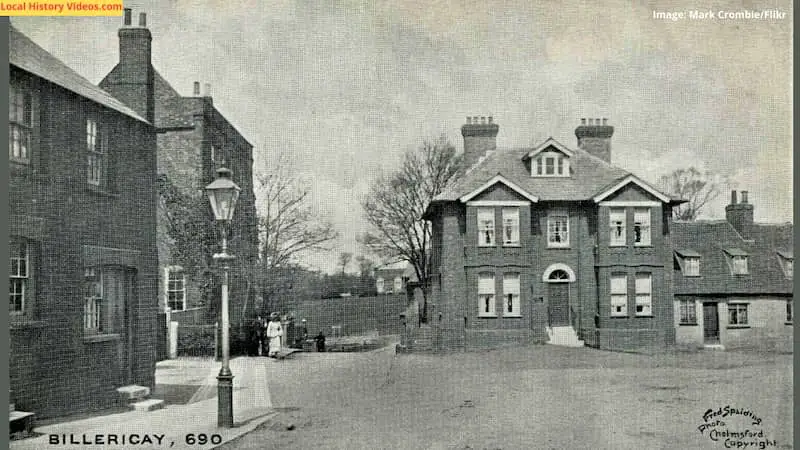

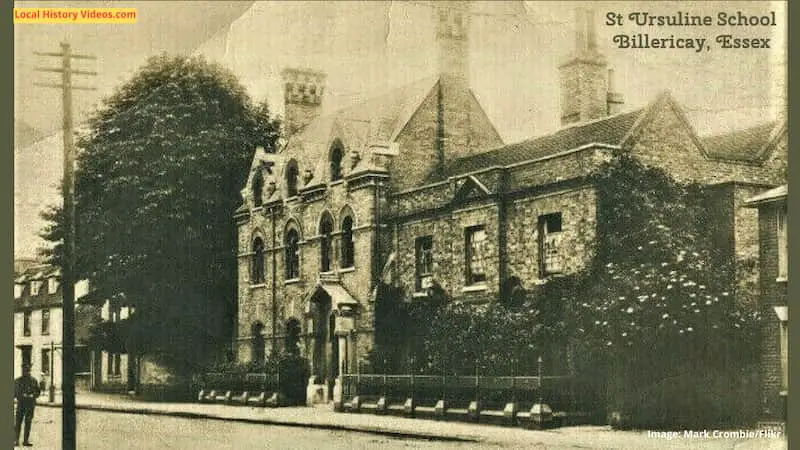
Mill Hill
The Billaricay windmill, is also known as the Great Bursted windmill. It was located on Southend Road at Mill Hill, now called Bell Hill.
After falling into disrepair, the old building was blown down in 1928. Over the road were two 18th century cottages, which are still standing today (portected by Grade II listings) near the entrance to Mill Meadows Nature Reserve.
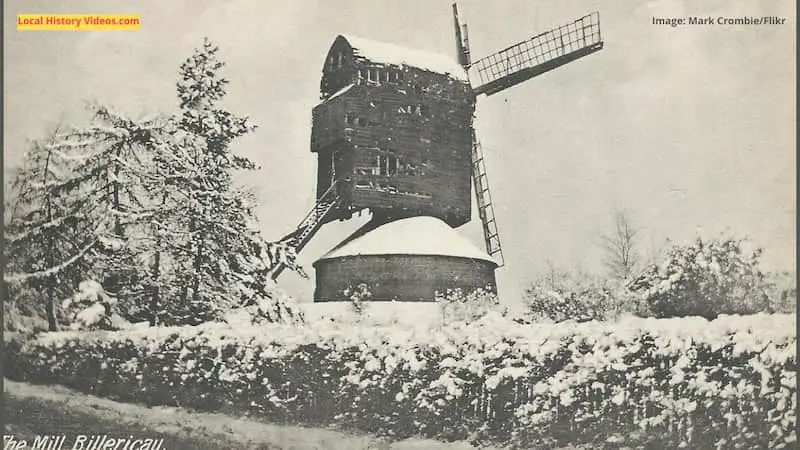
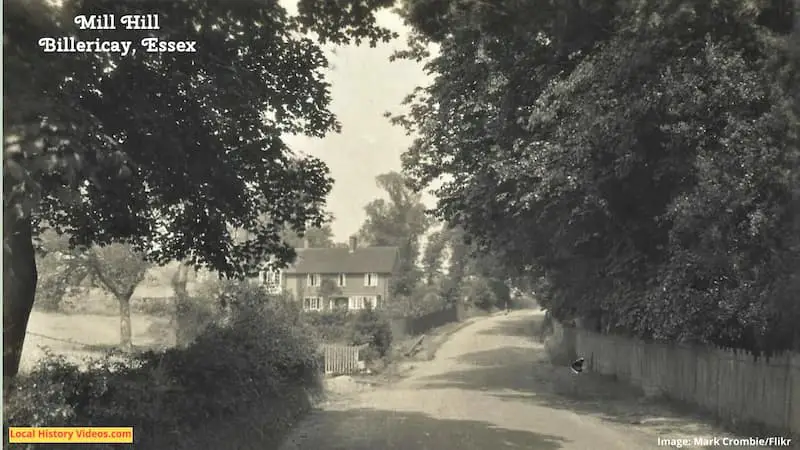
South Green
This photo postcard of South Green was published sometime around 1915.
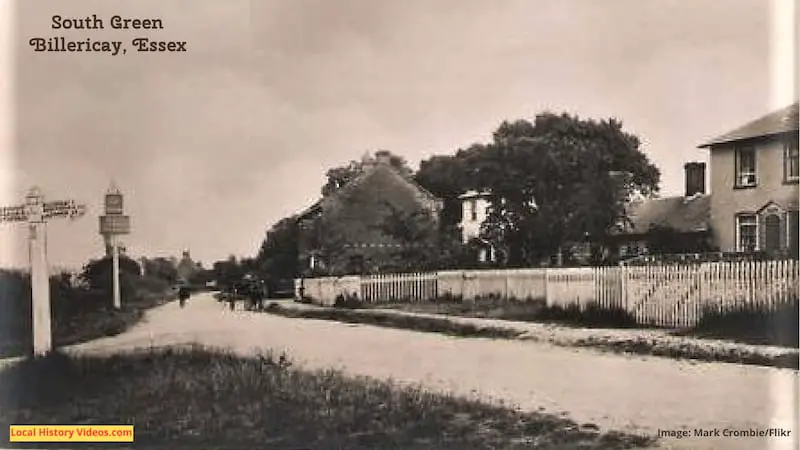
Billericay in 1959
A home made cine film records what Billeray’s streets, businesses and houses looked like at the end of the 1950s.
Billericay 1959 – Billericay Community Archive on YouTube
Historic Book
Extract from: “The Essex Review – An Illustrated Quarterly Record of Everything of Permanent Interest in the County … · Volumes 3–42“
Published in 1894
Pages 180 – 190
BILLERICAY by B.R. Branfill
THE origin and meaning of this name has been a puzzle to
antiquaries and others , although from time to time the
place has emerged from the obscurity of a country hamlet , with
claims to notice in the local annals of Essex , if not even in those
of more general history .
In the middle of the fourteenth century
it was a ” head centre ” and resort for the discontented peasantry of
the surrounding district , who felt the oppression of the manorial
system and the burden of taxation to be intolerable ; so much so
that the Essex malcontents were among the first to rise in arms , or ,
rather , without arms , against it .
Crossing the Thames under John
Rakestraw and Watte Tegheler , in 1381 , they joined the Kentish
insurgents , and by a forced march on London , where they were
welcomed by the malcontents of the capital , surprised the Court , and
obtained from the young king , Richard II , a promise that their
grievances should be redressed and their insurrection pardoned .
Upon
this they retired , but on learning that the great feudal lords , with
their armed retainers , were gathering together against them , and that
the king’s promises would not be allowed to hold good , they reas
sembled at Billericay , and , entrenching themselves in the woods
around , fought two desperate fights before they were subdued .
In the bloody reckoning which followed , Billericay furnished its full
share of the victims .
In the middle of the sixteenth century the Billericay neighbourhood was noticeably to the fore in the number of its martyrs who suffered at the stake for conscience sake .
Again , in the seventeenth century , we find notices of several persons
of this place who were punished for heresy or nonconformity , and
emigrated to the New World to escape further persecution . Some
four or five of these were amongst the immortal band of ” Pilgrims “
who sailed in the Mayflower in 1620 , and others followed soon
after , sufficient in number and influence to found a new township ,
which they named Billerica , after their native place .
As to the form of the name , like very many other proper names ,
it has varied according to the fancy of the writers , but not more so
than might be expected for so unusual a name , the pronunciation of
which , even at the present day , varies considerably amongst
strangers or those not to the manner born . For several years after
the line of railway to Billericay was opened it was amusing to notice
the different ways of pronouncing the name at the London terminus
and intermediate stations . Accentuating the syllable on which the
predominant vocal stress is laid , we have heard , and still sometimes
hear , Bil – ri – kay ‘ , Bil – le – rick ‘ – y , Bil – ree ‘ – ky , Bil – lerr ‘ – i – ky , Bill ‘ – ri – ky , and
the modern usage of the natives , Bil ‘ – ler – i – ky or Bill ‘ – ericay , the
three last syllables being short or lightly sounded . The final y
seems to be a comparatively modern addition , as the most usual form
before the seventeenth century was Billerica , and that this was con
sidered the correct form is conclusively shown by the name
of the Massachusetts Billerica , the accepted date of the incor
poration of which is May 29 , 1655 ; but the terminal y had then
very nearly grown to be usual , for , in their petition for independent
recognition , the founders asked that it might be named Billericay ,
and , eventually , in the grant of incorporation of the new
” Plantacion , ” made by the general court , the name stands
” Billirikeyca , ” whence it would seem that the ca had been added as
a correction , and in substitution for the preceding key , for imme
diately after and thenceforward the accepted form is ” Billerica . “
With regard to the spelling we notice the references to the name
found in the histories below – mentioned .
Holland’s translation of Camden’s Britannia ( edition of 1637 ) ,
first published in 1586 , has the following notice of the Essex
Billericay : ” Byliricay : a mercat Town of very good resort . “
Newcourt , in 1710 , writing in the first person , uses ” Billericay , “
and he should have known what was the proper form , having been
present at the re – consecration of the chapel here as ” Notary Publick
and Deputy Register , ” on October 8 , 1693. But , quoting from
Bonner’s Register , he has ” Billerica . “
repeatedly .
W. Holman , who died in 1730 , uses ” Billerica . ” Dr. Salmon ,
died 1742 , uses ” Billericay ” Billericay ” repeatedly . Nehemiah Wallington
( 1650 ) is quoted as using the form ” Billericay ” in his historical
notices of the reign of Charles I. Mr. J. A. Sparvel – Bayly quoting
the Public Records relating to Hadleigh Castle ( 40-42 , Edw . III ) ,
gives the form ” Billeryke ” ; and also in the extract from the Patent
Roll , 5 Edw . VI ( 1551 ) , granting ” the late free chapel or chantry “
to Walter Farre and Ralph Standysshe , gives the form ” Billerykay “
once , but ” Billerica ” occurs in it seven times ..
The mother – town of Billerica , in Essex , being only a hamlet in
the parish of Great Bursted , and not being the seat of either of the
Manors , is not found in Domesday Book relating to Essex . It is
stated , however , that the house now occupied by Mr. C. Richardson ,
in High Street , was always considered to be the Mansion of the
Manor of Cowbridge Grange , in Mountnessing parish , and some
early mention of the name may be looked for in ancient documents
relating thereto . Morant ( History of Essex , vol . ii , p . 198 ) , under
the name of ” Billerca ” ( which form is repeated at the end of the
article , on p . 199 ) , states that the first mention of the name found
is dated 1343 , under the form ” Belenca , ” on which he builds an
ingenious etymology . Dr. Salmon and W. Holman , following
Thomas Jekyll ( who died 1652 ) , preceded Morant , and they both
give the name as ” Beleuca , ” apparently from the very same docu
men : quoted by Morant . Mr. Walter C. Metcalfe , however , has
lately re – examined the original ( Inquis . p . m . Tho . Malegreff , 17
Edw . III ) in the Public Record Office , and , although the name is
now nearly obliterated , with the aid of one of the official experts he
pronounces that ” it certainly is Billerica , and it is found so copied
in a calendar made about 200 years ago , when the Inquisition must
have been easily readable . “
Morant , however , must have been aware of an carlier mention
of the name Billerica , for at vol . i , p . 167 , s.v. , Markeshall , in giving
the genealogy of the Honywood family , we find ” Edwin de Hony
wood ( temp . Henry III & Edw . I ) married Amabilia , daughter and
heir of Nicolas de Handlo , of an ancient and noble family in Kent ;
the capital seat of whose Barony was Bellerica , or Court – up – Street in
Allington , not far from Hony wood ; which by their means obtained
the privilege of a market . “
With reference to the origin and etymology of the name , what
has been written about the Kentish Billerica in the following extracts
from Hasted’s Kent and Leland’s Itinerary will be of interest in our
present inquiry .
In Hasted’s Kent , vol . viii , p . 292 , we find , s.v. Limne :
” Street is an eminent manor at the bounds of this parish , near the foot of the
same ridge of hills within the liberty of Romney Marsh . It is written in Domes
day Estraites , and afterwards usually Court – at – Street , but vulgarly Court – up – Street ,
taking its name from the court or manor of it , and its situation near the Street ,
or Via – Strata of the Romans . It was situated close to a town or hamlet once .
here , which was antiently called Billerika , as appears by the escheat – rolls of the
reigns of Edward III and Richard II , the ruins of which may in some measure
be still traced out …. the common report has been , that the town here had
been once very large , though now there remains only a cottage near the chapel ,
and a house or two near the summit of the hill . Leland , in his Itinerary , vol . vii ,
p . 142 , says , Billerica is a bowte a myle fro Lymme hille and at this day yt is a
membre of Lymme paroche … Hard by this chaple apere the old ruines of a
castelet wherbi yt may be thowght that the place and the towne there was cawled
Belirica , as who showld say in Latyne , Bello – castrum , and that the new name of
Cowrt – up Streate began by reason of the place or cowrt that the lord of the soyle
kept ther . The commune voyce is ther that the towne hath bene large , and they
shoe now theyr signa prætoriana , that is to say a horne garnished with brasse and
a mace ; but the likelyhood ys , that they longed to Lymme sumtyme a notable
towne and haven . ‘ “
Hasted has here quoted Leland correctly enough , but has omitted
to give Leland’s head – line- ” Belirica , alias Belcaire , and Cowrt – up
Strete ” ; and the marginal entry , which stands thus : ” Cowrt – up
Streate , alias Billirica , longeth to one M. Coluyle , Knight . “
From the foregoing extracts , the name Billerica or Belirica seems
to have preceded the name Street or Court – at – Street ( the Estraites of
Domesday Book ) .
Mr. C. Roach Smith mentions ” Belerica or Court – at – Street , a
mile N.N.W. from Lymne Castrum , where are remains of a castle , “
and he quotes Leland as above . He also mentions ” Saxon remains ,
interments , near Lymne at the edge of the hill at Bellevue , many
years since , referable to the 6th or 7th century ” ; and adds , ” The
ornaments closely resemble those found at the graves at Bel – air , near
Cheseaux – sur – Lausanne , in Switzerland . “
Leland ( Itinerary , vol . vii , part i , fol . 20 , 1550 ) , with reference to
” Strateforde Abbaye , ” founded about 1135 , states :
” This house first sett amonge the low marsches , was after , with sore fludes
defacyd , and remevid to a celle or graunge longinge to it caullyed Burgestede , in
Essex , a mile from Billirica . These Monks remained at Burgestede untyll
entrete was made that they might have sum helpe otherwyse . Then one of
Richards Kings of England tooke the ground and Abbaye of Strateforde into his
protection , and reedifienge it , brought the foresayd Monks agayne to Strateforde ,
where amonge the marsches they re – inhabytyd . “
This shows that Leland must have been acquainted with the
Essex Billirica , to the notices of which we now return .
In 1253 ( cart . 37 , Henry III ) the monks obtained a grant of a
market and a fair at Great Bursted , so that they had probably settled
here before that date , and Morant ( ii , p . 196 ) cites Inquis . 47 ,
Henry III ( 1263 ) to show that they already held most of the lands
in this parish , and up to 1358 they received four or five other
grants of land here .
It is not clear when they left Bursted Grange
to re – occupy the abbey at Stratford , but probably between 1380 and
1400 , during Richard II’s reign .
If the monks had not already
left their country settlement at the outbreak of the peasant insurrec
tion in 1381 , they would probably be very ready to do so then ,
rather than stay longer in such a hotbed of disaffection – a disaffec
tion which the wealthy monasteries and Church dignitaries shared
with the secular lords of the soil .
However that may be , they did
leave , and their departure naturally led to the decline of the popu
lation and importance of the Bursted Grange settlement , and con
sequently to the emergence from obscurity of the hamlet of
B.llerica , situate on the high ground at the cross – roads or four – want
way , which was probably a more convenient place of resort for
traffic .
Another likely cause for the abandonment of the old site
may be found in the fearful ravages of the Black Death in the latter
half of the fourteenth century .
At all events , in 1476 ( Pat . Roll .
16 , Edward IV ) the grant of a market and two fairs was obtained ,
to be held at Billerica , apparently by transfer from Bursted Grange .
Other advantages of the new site are found in the nature of the soil ,
light and gravelly on the surface , overlying a bed of pure sand some
forty feet in depth , above the impervious ” London clay , ” affording
a plentiful supply of good water ; whereas the old site about the
Grange lies 150 feet lower , on heavy , cold soil , and dependent for
good water upon the spring at the old parish church . This is cer
tainly a remarkably good one , such as is very rarely fourd hereabouts
at the level of 180 feet above the sea , at which it flows out , and no
doubt this spring was the prime cause of the selection of the spot
for a Christian baptistry , and probably a pre – Christian place of
worship ; but it was insufficient for the needs of any considerable
population .
These explanations are perhaps not very satisfactory ,
because the privilege of a market was granted in those days rather
for the profit of the lord of the manor or patentee than for the
advantage or convenience of the people who frequented it ; and the
site of a market does not necessarily imply density of the resident
population thereat .
The transfer of the market and fair from the
vicinity of Bursted Grange , or Church Street , to High Street , about
a mile and a quarter distant , may signify the re – occupation of the
more ancient centre of population , which had been interrupted only
during the two centuries or so that the abbot and monks of Strat
ford Abbey made their headquarters here .
The traces of Roman or Romano – British interments which have
been found so extensively on the high ground at Billericay prove that
it was occupied in Roman times , and the fact that the old military
road from Tilbury to the north passed straight along the ridge form
ing the single street of the hamlet , called High Street , where it is
crossed by the road from Ongar and Brentwood to Rayleigh and
Shoebury , render it probable that Billericay was occupied as a
military post by the Romans . A consideration of the topographical
features of the surrounding country , with a careful inspection of the
ground , tends to support this proposition . The Billericay ridge is
about 320ft . above sea , and is isolated , or , rather , peninsulated , by
low ground , from similar hills or ridges around it , from five to ten
miles distant , but well in sight and within reach in case of necessity .
To name some of these , with their distance , direction , and height
above sea , we have : Laindon Hills , 5 miles off to the south , and
378 feet above sea ; Rayleigh , 8 miles E.S.E. and 250 feet ; Dan
bury , 9 miles N.E. and 366 feet ; Stock , 3 miles N. by E. and
315 feet ; Highwood , * 5 miles , N.N.W. and 325 feet ; Blackmore
( Nine Ashes ) , 7 miles N.W. and 321 feet ; Kelvedon Hatch , 7
miles W.N.W. and 339 feet ; Southweald * ( camp near Caldicoie
Hall ) , 6 miles W. half N. and 300 feet ; Brentwood ( High Street ) ,
4 miles W. half S. and 352 feet ; and Warley Common , 5 miles
distant and 378 feet above sea . Besides this a good , though distant ,
view of the Thames with its shipping is had between Purfleet and
Grays , twelve miles to the southwest , over Bulphan and Orsett
Fens , and again to the southeastward , from Hole Haven , over
Canvey Island , nearly to Leigh Roads , from ten to twelve miles off .
The Crouch or Burnham River is also visible below Battlesbridge ,
seven miles off to the east , where sailing boats can be seen in fair
weather , especially at high water . Such an advantageous post of
observation in the midst of so many other points , which were also
occupied in Roman times , was not likely to be neglected . This
being so , no doubt the name given to it by the Romans would be
either a British , or , at least , a pre – existing name Latinised , or a
descriptive name in Latin . Whatever it was , we have no means of
knowing unless we find it mentioned in history , or find some name
so like it , or so analogous to it , and so suitable to the circumstances ,
that we can reconstruct or discover it ; and the object of this paper
is to stimulate inquiry and discussion amongst philologists and
antiquaries , in the hope that by some happy chance the riddle of the
lost origin of the name may be solved .
That the original name was lost for a very long time , and perhaps
for ever , is not to be much wondered at when we consider the small
proportion of the Roman place – names that have come down to us .
The Saxon folk who superseded the Romanised Britons appear to
have driven them out root and branch , and , in rural places at least ,
to have almost exterminated them , leaving only their roads , the
ashes of their habitations , and their sepulchral interments to testify of
their previous existence . Except the great Roman towns and fortified
places which they occupied the Saxons seem to have avoided using the
sites of their predecessors , or , if they re – inhabited them , they named
them anew , or else altered the old names almost beyond recognition .
We may now proceed to mention some of the derivations of the
name which have been proposed . As before mentioned , Leland
gives the forms ” Belirica or Belcaire , ” and suggests Bello – castrum
for the derivation ; and , in connection with the Roman Portus
Limanis , which is very near the site of the Kentish example , the
suggestion seems plausible , the more so as the Essex Billerica is also
on a Roman road where Romano – British remains have been found ,
and both sites are likely ones for a military post . The form Belcaire ,
Leland’s authority for which does not appear ( but Hasted and other
historians follow him ) , seems to be a likely Norman guise , recalling
Beaucaire ( = bellum quadrum , ” fair square ” ) , at the mouth of the
Rhone ; Belcarra ( Ireland ) ; Belcastro ( Italy ) ; Belgard ( Germany ) ;
Belchamp ; Belgrade ; Belvidere , etc. , etc.
Shortly before his death , the late Mr. H. W. King , of Leigh , so
long the valued hon . secretary of the Essex Archæological Society ,
wrote as follows to the present writer : ” Bello castrum seems a very
plausible derivation for the name . I had proposed Beli’r cae =
‘ devastation of the fortress , ‘ but this was pronounced untenable by
Welsh scholars ; the form would rather have been Caer beli .
Belleri Castra , the Castrum of the Belleri , ‘ has been suggested , but
it must first be shown that there ever was such a tribe , or such a
name as might be so Latinised . “
A Welsh friend has recently contributed the following for the
derivation of Billericay , as if from Penllergaer ( Glamorganshire ) =
” the height where the fort stands , ” an actual Welsh place – name ,
and he traces the steps of the change from the ancient British to the
modern form thus : Penllergaer , Benllergaer , Bellerga , Billerca ( the
last a form found in use within the last century or so , and one
printed at the head and end of his article on the place by Morant ,
vol . ii , p . 198 ) , whence Billerica , and the more modern form ,
Billericay . It may be worth repeating that the present locally
accepted pronunciation is ( qu . ) Bill – ri – ky , and sometimes , in the
mouths of old natives , Bill – icky or Bill – igy .
Morant , under Billerca ( vol . ii , p . 198 ) , referring to Inquis . p.m.
17 Edw . III , gives Beleuca as the earliest recorded form found , and
proceeds :
That nam , Beleuca , was probably derived from the old word Beleuga or
Banleuga , denoting a territory or precinct round a borough or manor ; in French ,
Banlieu . But how it came to be transformed into Billerica , which name it bore
in 1395 [ sic ] , Inquis . 9 Ric . II , we cannot even guess ,
Dr. Salmon , referring to the same document ( Inquis . 17 , Edw .
III ) , gives the name Belenca ( as also does W. Holman ) and
suggests ” if Belenca be Billericay Latinised we may believe it was
first called Vill de Crey , ” referring to the family of de Crey , of the
neighbouring parish of Ramsden Crays : ” or , ” he adds , ” Belenca
might have sprung out of Ville antique . ” As , however , it now
appears from the re – examination of the document cited , as before
mentioned , that the name was certainly not either Beleuca or Belenca ,
but Billerica , the suggestions of Salmon and Morant , based on
those erroneous forms may be now finally dismissed . Another
quotation given by Morant ( vol . ii , p . 198 ) , requires explanation . It
is from the Book of Chantries , and , after referring to ” the chapple of
Bursted Magna , which said chapple is distant from the Parish
Church a mile and a quarter , ” continues : ” The said Towne of
Bursted ys a great Towne and populous , and also a Haven Towne ;
there ys in it by estimacon about the numb . of 600 houseling people
and more . Yt ys no Parish , but the Incumbent celebrateth in the
said Chappel of Much Bursted . ” It is not easy to see how Billericay
can ever have been termed a ” Haven Towne . ” Could the form of
the name Billericay ( quasi Billeri – quay ) suggest to the writer in the
Book of Chantries that the name must belong to a Haven town , or
could he , for the moment , be confounding it with the Kentish
Billerica , which might possibly be termed a Haven Town , being in
the same parish as the famous Roman port ? This question awaits
explanation .
The question now arises , in what language may we expect to find
the original significant particles that were used in forming the name
Billerica in the Celtic , ie , the British or Romanized British ; or
in the Teutonic , i.e. , the Anglo – Saxon and the allied languages
spoken by the Dancs or by the Normans ?
A Celtic or Romano – British source for the name seems at first
sight by no means unlikely , secing the extensive finds here which
have been referred to Romano – British times . But so few traces of
the Celtic have survived in the nomenclature of the district , except
ing the river names , that we can hardly hope for much help from
this source , without going farther afield .
The following gleanings and suggestions have , however , been
kindly communicated : ” Under date , 719 , A.D. , there appears ( in
the Trad . Wis . , n . 267 ) , ‘ Ad Biloeraka – wilare in Pago Sarninse , ‘
i.e. , in the District of the Saar , a tributary of the Mosel , where in the
time of S. Jerome ( 4th Cent . ) , the language was Celtic . ” ” Also ( in
the l’ard . Diplom . ) the modern Beaurains in the Pas de Calais
appears as Belrenio , for Bellir inum : whence we get a genuine Celtic
Bellir , and the adjectival -in , like ic , ac , -oc , is common Celtic
usage . ” This name , however , recalls Bellerby ( Yorkshire ) , of
probably Danish origin . Mr. T. C. Chisenhale Marsh’s translation
of Domesday Book for Essex gives the following derivation , pro
posed by Mr. Jenkins , of Colchester : Bel , the British Mars ; Wyr ,
descendant ; and Cae , inclosure , camp .
Failing the Celtic we have the great store of Anglo – Saxon speech
in which to search for the significant rootlets of the name . A very
large majority of the place names in Essex show an Anglo – Saxon
origin . Of the 330 different place – names in the index to The People’s
History of Essex we have about sixty various suffixes , fifty of which
are Anglo – Saxon , and most of the remainder are Norman or Danish .
So that Anglo – Saxon seems to be the most likely source for the
derivation of the name . We are told that ” in Domesday there
appears a Bilre – broch in the hundred of Offelan , Staffordshire ; and
in a charter of A.D. 802 there appears a Bilre – beke , in Westphalia .
Beke and the preceding Broch ( = brook ) representing stream . “
This Bilre – beke , we learn , is rendered Billarbeci in a charter of
A.D. 834 , Billarbeki in 1030 , and is now Billerbeck near Coesfeld ,
thirteen miles west of Münster . But even if we found an actual
English name Billerich or Bilric , the terminala or -ay still remains
to be accounted for . It has been suggested that the ay may repre
sent haga , an enclosure , thus Bilric ay = Bilric’s haga ; the elision
of the s , however , in the transition would be unusual ; but we have
Brighton for Brighthelm’s – tun , and Billinghay , Lincolnshire , which
may represent a former Billing’s haga . The terminal hay in
Urishay , Herefordshire , is said to represent an older haigh or
haga .
An eminent philologist has suggested the following derivation ,
which seems to suit the situation on a flat – topped hill or ridge , a
topographical feature common to both the Essex and the Kentish
Billerica : the Teutonic root bill , level or flat ; and M.E. rigge , a
dative form from A.S. hryeg , a back or ridge ; the whole name
signifying the flat – topped or level ridge , which is as good a descrip
tive name as could be expected . Curiously enough the height above
sea is nearly the same in both instances – a little over 300 feet .
An objection to this derivation is that flat – toppedness is by no
means a distinguishing feature of the hills and ridges , in Essex at
least , where all are flat – topped , and might be rather termed plateaux
than hills . Perhaps , however , they may have seemed grand hills to
the East Saxon settlers by comparison with the much flatter country
they had come from ; and hence , perhaps , the great number of -dons
we find in the nomenclature of this county .
A Norman source for the name is largely contradicted by its non
appearance in Domesday , coupled with the fact that it was neither
the seat of a manor nor of an ecclesiastical house . Still , the form
Belcaire , the alternative for the Kentish Billerica , looks as if the
Norman invaders had recognised the name , and had given it a
Norman – like garb to live in .
The writer is quite incompetent to deal properly with the
etymology of the name , and only hopes that some who are fully
qualified may have the opportunity to seek and the good fortune to
discover our long lost origin .
More about Essex
- Old Images of Essex, England
- Old Images of West Hangingfield, Essex
- Old Images of Purfleet (Purfleet-on-Thames), Essex
- Old Images of Wickford, Essex
- Old Images of West Thurrock, Essex
- Old Images of Walton-on-the-Naze, Essex
- Old Images of Tilbury, Essex
- Old Images of Thaxted, Essex
- Old Images of South Ockenden, Essex
- Old Images of Shoeburyness, Essex
- Old Images of Rochford, Essex
- Old Images of Maldon, Essex
- Old Images of Leigh-on-Sea, Essex
- Old Images of Harwich, Essex
- Old Images of Harlow, Essex
- Old Images of Halstead, Essex
- Old Images of Frinton-on-Sea, Essex
- Old Images of Chigwell, Essex
- Old Images of Canvey Island, Essex
- Old Images of Burnham-on-Crouch, Essex

